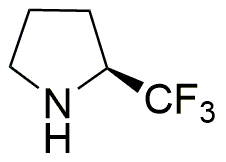(S)-(+)-2-(Trifluoromethyl)pyrrolidine is widely utilized in research focused on:
- Pharmaceutical Development: This compound serves as a key intermediate in the synthesis of various pharmaceuticals, particularly in the development of drugs targeting neurological disorders due to its unique structural properties.
- Agrochemical Formulations: It is employed in the creation of innovative agrochemicals, enhancing the efficacy of pesticides and herbicides by improving their stability and bioavailability in agricultural applications.
- Material Science: The compound is used in the production of advanced materials, such as polymers and coatings, where its trifluoromethyl group imparts desirable properties like chemical resistance and thermal stability.
- Research in Organic Chemistry: It acts as a valuable reagent in organic synthesis, facilitating the formation of complex molecules and enabling researchers to explore new chemical reactions and pathways.
- Fluorine Chemistry Studies: This compound is significant in the field of fluorine chemistry, allowing scientists to investigate the effects of fluorination on molecular behavior and reactivity, which can lead to the development of new materials and compounds.
Informations générales
Propriétés
Sécurité et réglementation
Applications
(S)-(+)-2-(Trifluoromethyl)pyrrolidine is widely utilized in research focused on:
- Pharmaceutical Development: This compound serves as a key intermediate in the synthesis of various pharmaceuticals, particularly in the development of drugs targeting neurological disorders due to its unique structural properties.
- Agrochemical Formulations: It is employed in the creation of innovative agrochemicals, enhancing the efficacy of pesticides and herbicides by improving their stability and bioavailability in agricultural applications.
- Material Science: The compound is used in the production of advanced materials, such as polymers and coatings, where its trifluoromethyl group imparts desirable properties like chemical resistance and thermal stability.
- Research in Organic Chemistry: It acts as a valuable reagent in organic synthesis, facilitating the formation of complex molecules and enabling researchers to explore new chemical reactions and pathways.
- Fluorine Chemistry Studies: This compound is significant in the field of fluorine chemistry, allowing scientists to investigate the effects of fluorination on molecular behavior and reactivity, which can lead to the development of new materials and compounds.
Documents
Fiches de données de sécurité (FDS)
La FDS fournit des informations de sécurité complètes sur la manipulation, le stockage et l’élimination du produit.
Spécifications du produit (PS)
Le PS fournit une description complète des propriétés du produit, notamment sa composition chimique, son état physique, sa pureté et les exigences de stockage. Il détaille également les plages de qualité acceptables et les applications prévues du produit.
Certificats d'analyse (COA)
Recherchez des certificats d'analyse (COA) en saisissant le numéro de lot du produit. Les numéros de lot et de lot se trouvent sur l'étiquette d'un produit, après les mots « Lot » ou « Lot de fabrication ».
Numéro de catalogue
Numéro de lot/série
Certificats d'origine (COO)
Ce certificat d'exploitation confirme le pays dans lequel le produit a été fabriqué, et détaille également les matériaux et composants utilisés et s'il est issu de sources naturelles, synthétiques ou autres sources spécifiques. Ce certificat peut être requis pour les douanes, le commerce et la conformité réglementaire.
Numéro de catalogue
Numéro de lot/série
Fiches de données de sécurité (FDS)
La FDS fournit des informations de sécurité complètes sur la manipulation, le stockage et l’élimination du produit.
DownloadSpécifications du produit (PS)
Le PS fournit une description complète des propriétés du produit, notamment sa composition chimique, son état physique, sa pureté et les exigences de stockage. Il détaille également les plages de qualité acceptables et les applications prévues du produit.
DownloadCertificats d'analyse (COA)
Recherchez des certificats d'analyse (COA) en saisissant le numéro de lot du produit. Les numéros de lot et de lot se trouvent sur l'étiquette d'un produit, après les mots « Lot » ou « Lot de fabrication ».
Numéro de catalogue
Numéro de lot/série
Certificats d'origine (COO)
Ce certificat d'exploitation confirme le pays dans lequel le produit a été fabriqué, et détaille également les matériaux et composants utilisés et s'il est issu de sources naturelles, synthétiques ou autres sources spécifiques. Ce certificat peut être requis pour les douanes, le commerce et la conformité réglementaire.


